Business Strategy and Organizational Management
VerifiedAdded on 2020/10/22
|12
|4118
|172
AI Summary
The provided report focuses on the size, scope, and objectives of various organizations. It emphasizes the importance of coordination between different divisions to achieve preset goals. The report also highlights the need for management to determine macro and micro environmental factors using SWOT and PESTLE models to eliminate negative impacts. The assignment draws from relevant books, journals, and online resources, covering topics such as business war gaming, logistical excellence, entrepreneurship, and analytic network process.
Contribute Materials
Your contribution can guide someone’s learning journey. Share your
documents today.
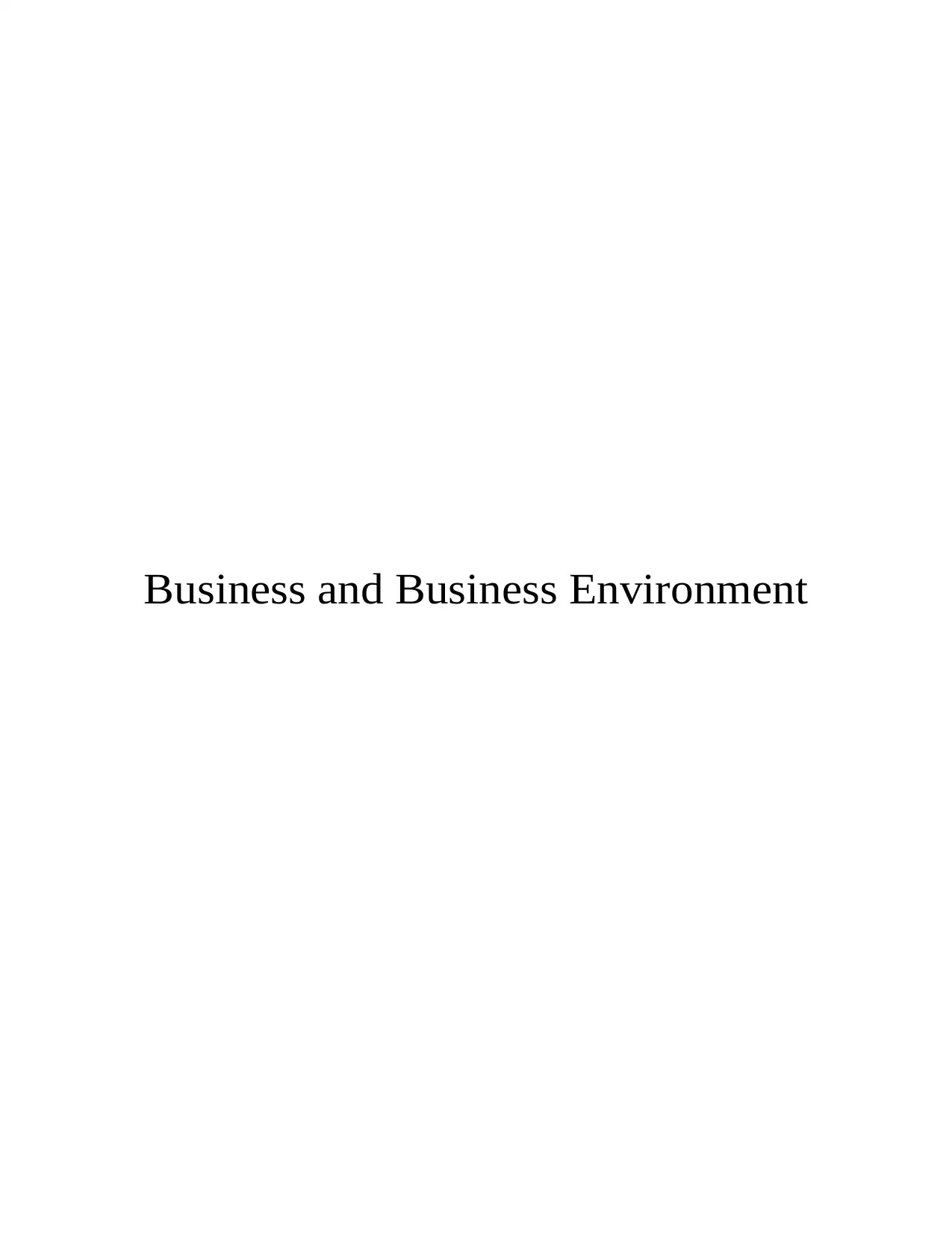
Business and Business Environment
Secure Best Marks with AI Grader
Need help grading? Try our AI Grader for instant feedback on your assignments.
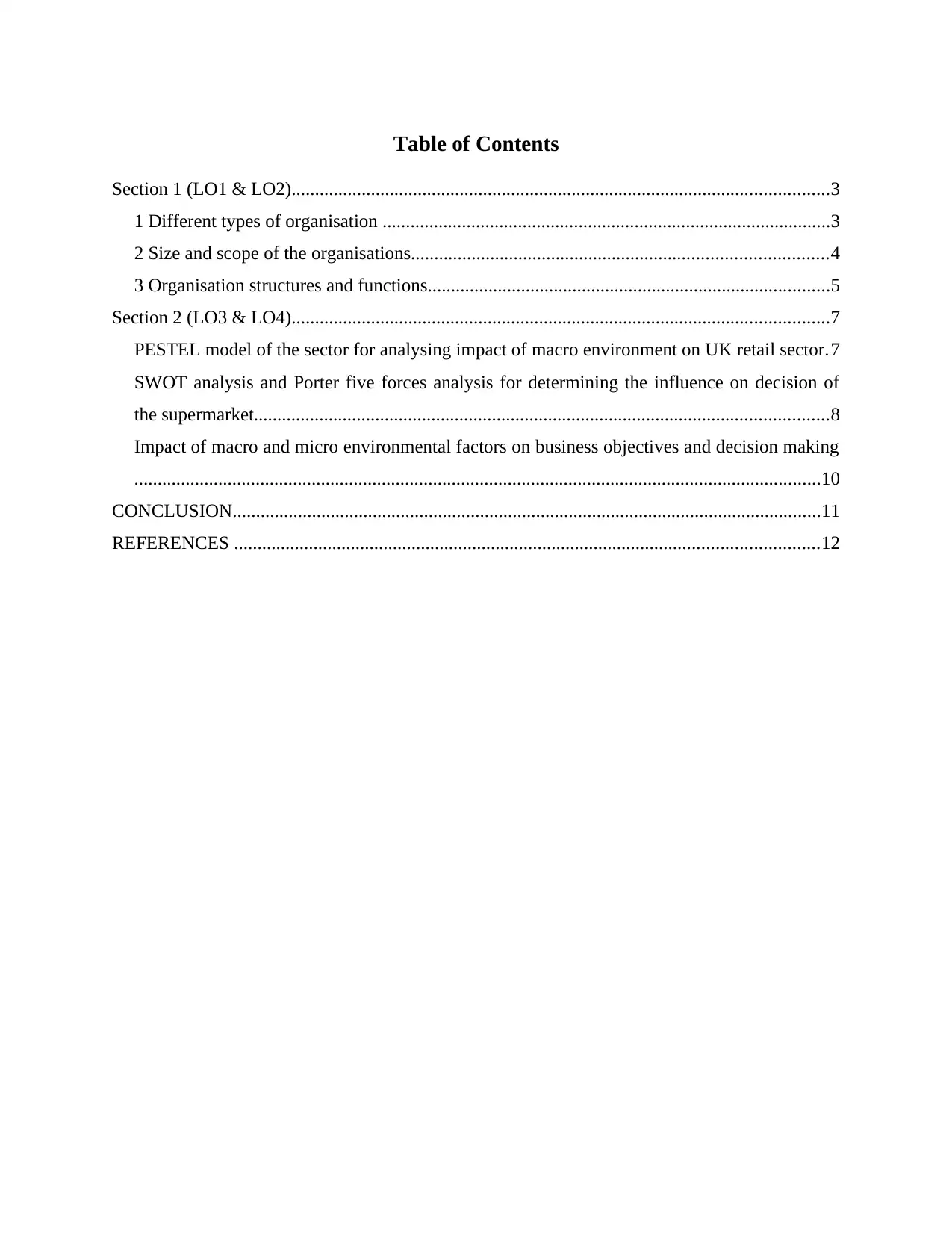
Table of Contents
Section 1 (LO1 & LO2)...................................................................................................................3
1 Different types of organisation ................................................................................................3
2 Size and scope of the organisations.........................................................................................4
3 Organisation structures and functions......................................................................................5
Section 2 (LO3 & LO4)...................................................................................................................7
PESTEL model of the sector for analysing impact of macro environment on UK retail sector.7
SWOT analysis and Porter five forces analysis for determining the influence on decision of
the supermarket...........................................................................................................................8
Impact of macro and micro environmental factors on business objectives and decision making
...................................................................................................................................................10
CONCLUSION..............................................................................................................................11
REFERENCES .............................................................................................................................12
Section 1 (LO1 & LO2)...................................................................................................................3
1 Different types of organisation ................................................................................................3
2 Size and scope of the organisations.........................................................................................4
3 Organisation structures and functions......................................................................................5
Section 2 (LO3 & LO4)...................................................................................................................7
PESTEL model of the sector for analysing impact of macro environment on UK retail sector.7
SWOT analysis and Porter five forces analysis for determining the influence on decision of
the supermarket...........................................................................................................................8
Impact of macro and micro environmental factors on business objectives and decision making
...................................................................................................................................................10
CONCLUSION..............................................................................................................................11
REFERENCES .............................................................................................................................12
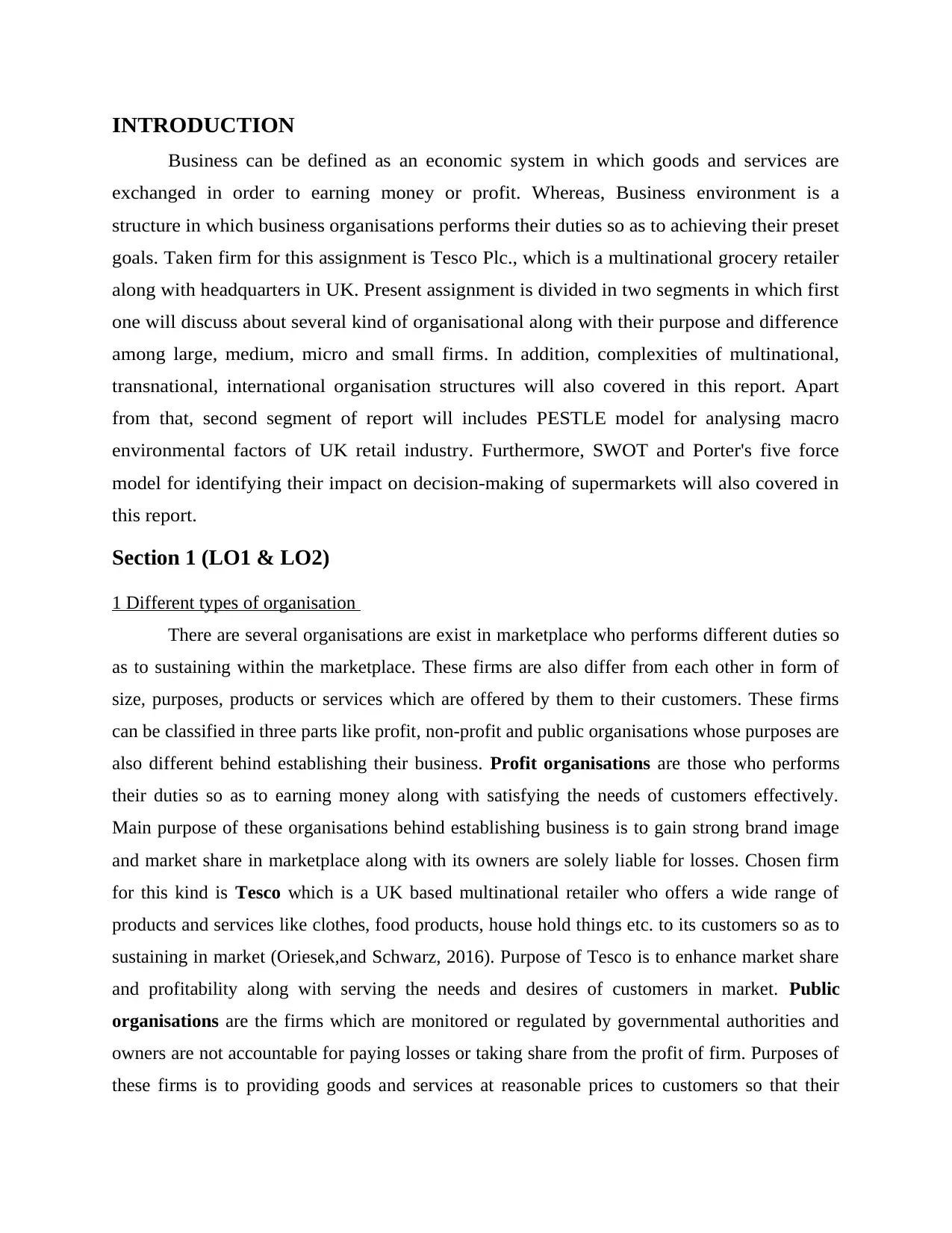
INTRODUCTION
Business can be defined as an economic system in which goods and services are
exchanged in order to earning money or profit. Whereas, Business environment is a
structure in which business organisations performs their duties so as to achieving their preset
goals. Taken firm for this assignment is Tesco Plc., which is a multinational grocery retailer
along with headquarters in UK. Present assignment is divided in two segments in which first
one will discuss about several kind of organisational along with their purpose and difference
among large, medium, micro and small firms. In addition, complexities of multinational,
transnational, international organisation structures will also covered in this report. Apart
from that, second segment of report will includes PESTLE model for analysing macro
environmental factors of UK retail industry. Furthermore, SWOT and Porter's five force
model for identifying their impact on decision-making of supermarkets will also covered in
this report.
Section 1 (LO1 & LO2)
1 Different types of organisation
There are several organisations are exist in marketplace who performs different duties so
as to sustaining within the marketplace. These firms are also differ from each other in form of
size, purposes, products or services which are offered by them to their customers. These firms
can be classified in three parts like profit, non-profit and public organisations whose purposes are
also different behind establishing their business. Profit organisations are those who performs
their duties so as to earning money along with satisfying the needs of customers effectively.
Main purpose of these organisations behind establishing business is to gain strong brand image
and market share in marketplace along with its owners are solely liable for losses. Chosen firm
for this kind is Tesco which is a UK based multinational retailer who offers a wide range of
products and services like clothes, food products, house hold things etc. to its customers so as to
sustaining in market (Oriesek,and Schwarz, 2016). Purpose of Tesco is to enhance market share
and profitability along with serving the needs and desires of customers in market. Public
organisations are the firms which are monitored or regulated by governmental authorities and
owners are not accountable for paying losses or taking share from the profit of firm. Purposes of
these firms is to providing goods and services at reasonable prices to customers so that their
Business can be defined as an economic system in which goods and services are
exchanged in order to earning money or profit. Whereas, Business environment is a
structure in which business organisations performs their duties so as to achieving their preset
goals. Taken firm for this assignment is Tesco Plc., which is a multinational grocery retailer
along with headquarters in UK. Present assignment is divided in two segments in which first
one will discuss about several kind of organisational along with their purpose and difference
among large, medium, micro and small firms. In addition, complexities of multinational,
transnational, international organisation structures will also covered in this report. Apart
from that, second segment of report will includes PESTLE model for analysing macro
environmental factors of UK retail industry. Furthermore, SWOT and Porter's five force
model for identifying their impact on decision-making of supermarkets will also covered in
this report.
Section 1 (LO1 & LO2)
1 Different types of organisation
There are several organisations are exist in marketplace who performs different duties so
as to sustaining within the marketplace. These firms are also differ from each other in form of
size, purposes, products or services which are offered by them to their customers. These firms
can be classified in three parts like profit, non-profit and public organisations whose purposes are
also different behind establishing their business. Profit organisations are those who performs
their duties so as to earning money along with satisfying the needs of customers effectively.
Main purpose of these organisations behind establishing business is to gain strong brand image
and market share in marketplace along with its owners are solely liable for losses. Chosen firm
for this kind is Tesco which is a UK based multinational retailer who offers a wide range of
products and services like clothes, food products, house hold things etc. to its customers so as to
sustaining in market (Oriesek,and Schwarz, 2016). Purpose of Tesco is to enhance market share
and profitability along with serving the needs and desires of customers in market. Public
organisations are the firms which are monitored or regulated by governmental authorities and
owners are not accountable for paying losses or taking share from the profit of firm. Purposes of
these firms is to providing goods and services at reasonable prices to customers so that their
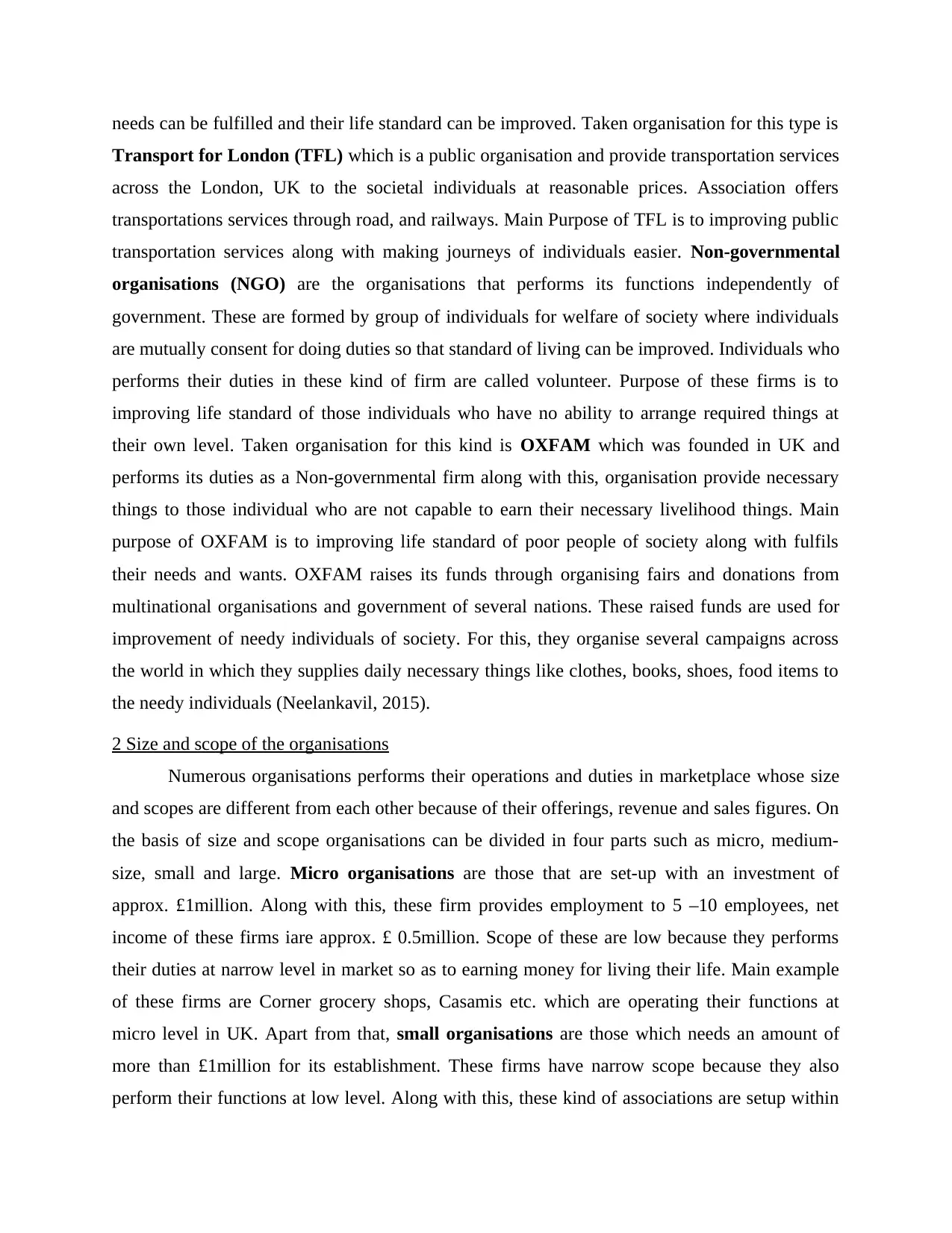
needs can be fulfilled and their life standard can be improved. Taken organisation for this type is
Transport for London (TFL) which is a public organisation and provide transportation services
across the London, UK to the societal individuals at reasonable prices. Association offers
transportations services through road, and railways. Main Purpose of TFL is to improving public
transportation services along with making journeys of individuals easier. Non-governmental
organisations (NGO) are the organisations that performs its functions independently of
government. These are formed by group of individuals for welfare of society where individuals
are mutually consent for doing duties so that standard of living can be improved. Individuals who
performs their duties in these kind of firm are called volunteer. Purpose of these firms is to
improving life standard of those individuals who have no ability to arrange required things at
their own level. Taken organisation for this kind is OXFAM which was founded in UK and
performs its duties as a Non-governmental firm along with this, organisation provide necessary
things to those individual who are not capable to earn their necessary livelihood things. Main
purpose of OXFAM is to improving life standard of poor people of society along with fulfils
their needs and wants. OXFAM raises its funds through organising fairs and donations from
multinational organisations and government of several nations. These raised funds are used for
improvement of needy individuals of society. For this, they organise several campaigns across
the world in which they supplies daily necessary things like clothes, books, shoes, food items to
the needy individuals (Neelankavil, 2015).
2 Size and scope of the organisations
Numerous organisations performs their operations and duties in marketplace whose size
and scopes are different from each other because of their offerings, revenue and sales figures. On
the basis of size and scope organisations can be divided in four parts such as micro, medium-
size, small and large. Micro organisations are those that are set-up with an investment of
approx. £1million. Along with this, these firm provides employment to 5 –10 employees, net
income of these firms iare approx. £ 0.5million. Scope of these are low because they performs
their duties at narrow level in market so as to earning money for living their life. Main example
of these firms are Corner grocery shops, Casamis etc. which are operating their functions at
micro level in UK. Apart from that, small organisations are those which needs an amount of
more than £1million for its establishment. These firms have narrow scope because they also
perform their functions at low level. Along with this, these kind of associations are setup within
Transport for London (TFL) which is a public organisation and provide transportation services
across the London, UK to the societal individuals at reasonable prices. Association offers
transportations services through road, and railways. Main Purpose of TFL is to improving public
transportation services along with making journeys of individuals easier. Non-governmental
organisations (NGO) are the organisations that performs its functions independently of
government. These are formed by group of individuals for welfare of society where individuals
are mutually consent for doing duties so that standard of living can be improved. Individuals who
performs their duties in these kind of firm are called volunteer. Purpose of these firms is to
improving life standard of those individuals who have no ability to arrange required things at
their own level. Taken organisation for this kind is OXFAM which was founded in UK and
performs its duties as a Non-governmental firm along with this, organisation provide necessary
things to those individual who are not capable to earn their necessary livelihood things. Main
purpose of OXFAM is to improving life standard of poor people of society along with fulfils
their needs and wants. OXFAM raises its funds through organising fairs and donations from
multinational organisations and government of several nations. These raised funds are used for
improvement of needy individuals of society. For this, they organise several campaigns across
the world in which they supplies daily necessary things like clothes, books, shoes, food items to
the needy individuals (Neelankavil, 2015).
2 Size and scope of the organisations
Numerous organisations performs their operations and duties in marketplace whose size
and scopes are different from each other because of their offerings, revenue and sales figures. On
the basis of size and scope organisations can be divided in four parts such as micro, medium-
size, small and large. Micro organisations are those that are set-up with an investment of
approx. £1million. Along with this, these firm provides employment to 5 –10 employees, net
income of these firms iare approx. £ 0.5million. Scope of these are low because they performs
their duties at narrow level in market so as to earning money for living their life. Main example
of these firms are Corner grocery shops, Casamis etc. which are operating their functions at
micro level in UK. Apart from that, small organisations are those which needs an amount of
more than £1million for its establishment. These firms have narrow scope because they also
perform their functions at low level. Along with this, these kind of associations are setup within
Secure Best Marks with AI Grader
Need help grading? Try our AI Grader for instant feedback on your assignments.
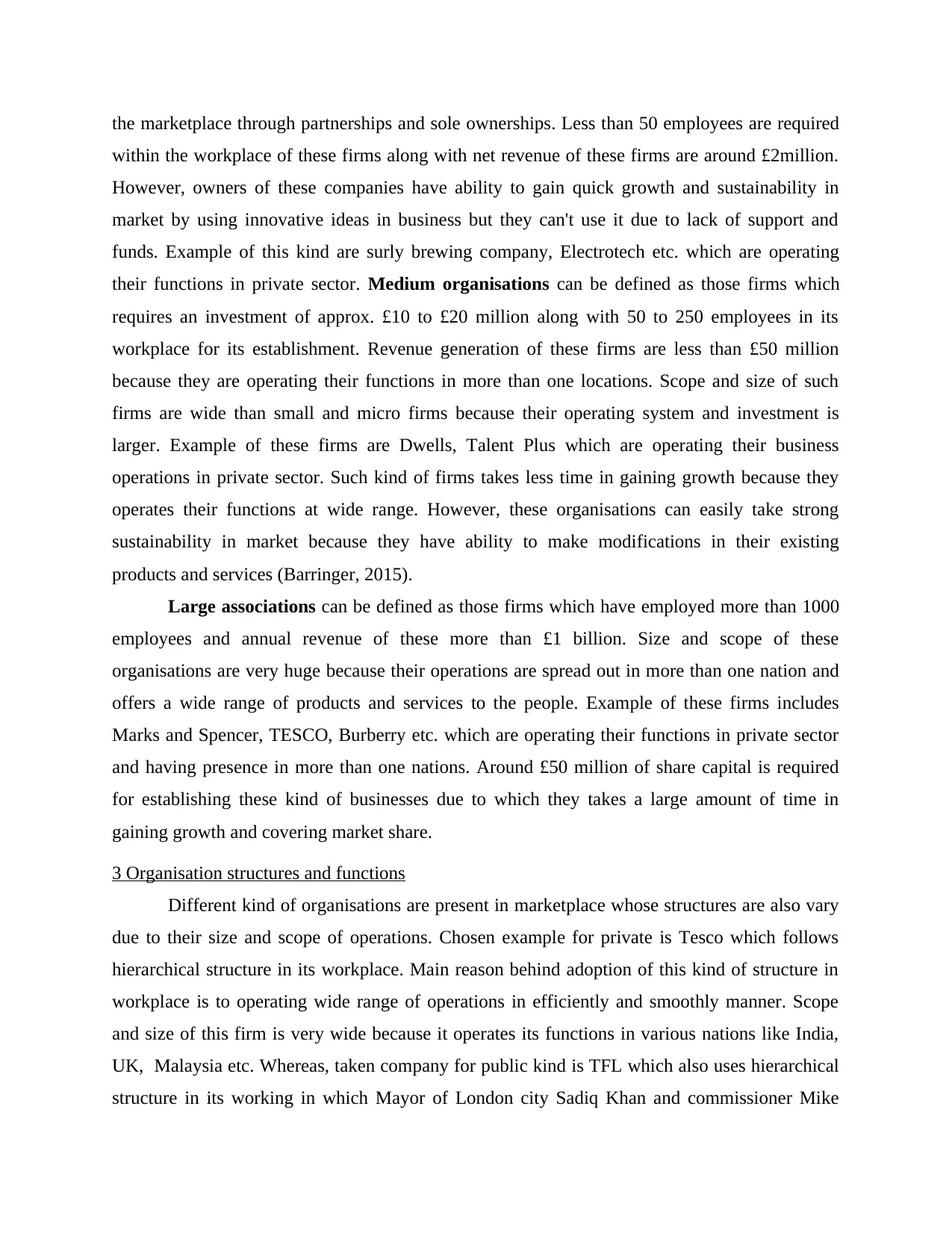
the marketplace through partnerships and sole ownerships. Less than 50 employees are required
within the workplace of these firms along with net revenue of these firms are around £2million.
However, owners of these companies have ability to gain quick growth and sustainability in
market by using innovative ideas in business but they can't use it due to lack of support and
funds. Example of this kind are surly brewing company, Electrotech etc. which are operating
their functions in private sector. Medium organisations can be defined as those firms which
requires an investment of approx. £10 to £20 million along with 50 to 250 employees in its
workplace for its establishment. Revenue generation of these firms are less than £50 million
because they are operating their functions in more than one locations. Scope and size of such
firms are wide than small and micro firms because their operating system and investment is
larger. Example of these firms are Dwells, Talent Plus which are operating their business
operations in private sector. Such kind of firms takes less time in gaining growth because they
operates their functions at wide range. However, these organisations can easily take strong
sustainability in market because they have ability to make modifications in their existing
products and services (Barringer, 2015).
Large associations can be defined as those firms which have employed more than 1000
employees and annual revenue of these more than £1 billion. Size and scope of these
organisations are very huge because their operations are spread out in more than one nation and
offers a wide range of products and services to the people. Example of these firms includes
Marks and Spencer, TESCO, Burberry etc. which are operating their functions in private sector
and having presence in more than one nations. Around £50 million of share capital is required
for establishing these kind of businesses due to which they takes a large amount of time in
gaining growth and covering market share.
3 Organisation structures and functions
Different kind of organisations are present in marketplace whose structures are also vary
due to their size and scope of operations. Chosen example for private is Tesco which follows
hierarchical structure in its workplace. Main reason behind adoption of this kind of structure in
workplace is to operating wide range of operations in efficiently and smoothly manner. Scope
and size of this firm is very wide because it operates its functions in various nations like India,
UK, Malaysia etc. Whereas, taken company for public kind is TFL which also uses hierarchical
structure in its working in which Mayor of London city Sadiq Khan and commissioner Mike
within the workplace of these firms along with net revenue of these firms are around £2million.
However, owners of these companies have ability to gain quick growth and sustainability in
market by using innovative ideas in business but they can't use it due to lack of support and
funds. Example of this kind are surly brewing company, Electrotech etc. which are operating
their functions in private sector. Medium organisations can be defined as those firms which
requires an investment of approx. £10 to £20 million along with 50 to 250 employees in its
workplace for its establishment. Revenue generation of these firms are less than £50 million
because they are operating their functions in more than one locations. Scope and size of such
firms are wide than small and micro firms because their operating system and investment is
larger. Example of these firms are Dwells, Talent Plus which are operating their business
operations in private sector. Such kind of firms takes less time in gaining growth because they
operates their functions at wide range. However, these organisations can easily take strong
sustainability in market because they have ability to make modifications in their existing
products and services (Barringer, 2015).
Large associations can be defined as those firms which have employed more than 1000
employees and annual revenue of these more than £1 billion. Size and scope of these
organisations are very huge because their operations are spread out in more than one nation and
offers a wide range of products and services to the people. Example of these firms includes
Marks and Spencer, TESCO, Burberry etc. which are operating their functions in private sector
and having presence in more than one nations. Around £50 million of share capital is required
for establishing these kind of businesses due to which they takes a large amount of time in
gaining growth and covering market share.
3 Organisation structures and functions
Different kind of organisations are present in marketplace whose structures are also vary
due to their size and scope of operations. Chosen example for private is Tesco which follows
hierarchical structure in its workplace. Main reason behind adoption of this kind of structure in
workplace is to operating wide range of operations in efficiently and smoothly manner. Scope
and size of this firm is very wide because it operates its functions in various nations like India,
UK, Malaysia etc. Whereas, taken company for public kind is TFL which also uses hierarchical
structure in its working in which Mayor of London city Sadiq Khan and commissioner Mike
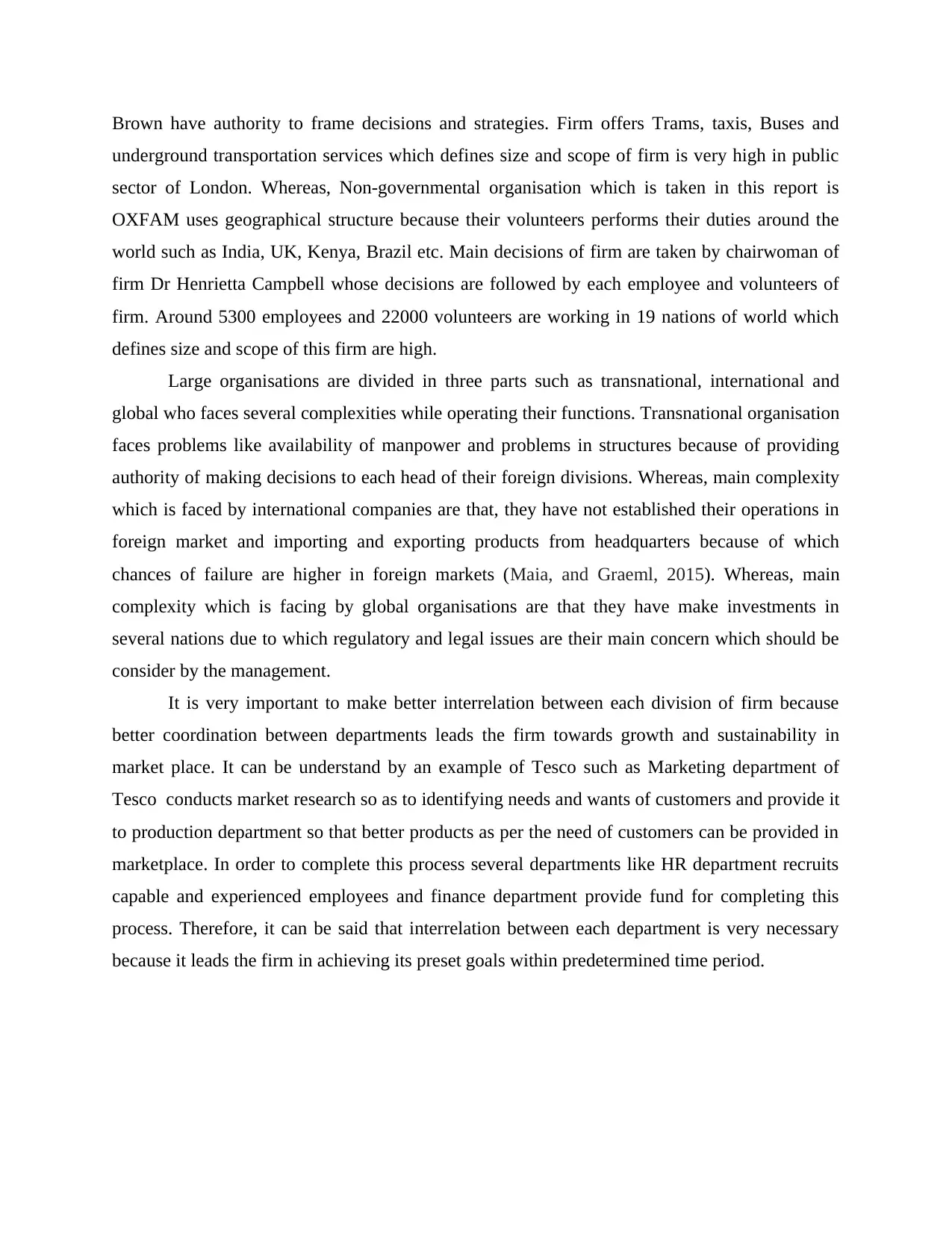
Brown have authority to frame decisions and strategies. Firm offers Trams, taxis, Buses and
underground transportation services which defines size and scope of firm is very high in public
sector of London. Whereas, Non-governmental organisation which is taken in this report is
OXFAM uses geographical structure because their volunteers performs their duties around the
world such as India, UK, Kenya, Brazil etc. Main decisions of firm are taken by chairwoman of
firm Dr Henrietta Campbell whose decisions are followed by each employee and volunteers of
firm. Around 5300 employees and 22000 volunteers are working in 19 nations of world which
defines size and scope of this firm are high.
Large organisations are divided in three parts such as transnational, international and
global who faces several complexities while operating their functions. Transnational organisation
faces problems like availability of manpower and problems in structures because of providing
authority of making decisions to each head of their foreign divisions. Whereas, main complexity
which is faced by international companies are that, they have not established their operations in
foreign market and importing and exporting products from headquarters because of which
chances of failure are higher in foreign markets (Maia, and Graeml, 2015). Whereas, main
complexity which is facing by global organisations are that they have make investments in
several nations due to which regulatory and legal issues are their main concern which should be
consider by the management.
It is very important to make better interrelation between each division of firm because
better coordination between departments leads the firm towards growth and sustainability in
market place. It can be understand by an example of Tesco such as Marketing department of
Tesco conducts market research so as to identifying needs and wants of customers and provide it
to production department so that better products as per the need of customers can be provided in
marketplace. In order to complete this process several departments like HR department recruits
capable and experienced employees and finance department provide fund for completing this
process. Therefore, it can be said that interrelation between each department is very necessary
because it leads the firm in achieving its preset goals within predetermined time period.
underground transportation services which defines size and scope of firm is very high in public
sector of London. Whereas, Non-governmental organisation which is taken in this report is
OXFAM uses geographical structure because their volunteers performs their duties around the
world such as India, UK, Kenya, Brazil etc. Main decisions of firm are taken by chairwoman of
firm Dr Henrietta Campbell whose decisions are followed by each employee and volunteers of
firm. Around 5300 employees and 22000 volunteers are working in 19 nations of world which
defines size and scope of this firm are high.
Large organisations are divided in three parts such as transnational, international and
global who faces several complexities while operating their functions. Transnational organisation
faces problems like availability of manpower and problems in structures because of providing
authority of making decisions to each head of their foreign divisions. Whereas, main complexity
which is faced by international companies are that, they have not established their operations in
foreign market and importing and exporting products from headquarters because of which
chances of failure are higher in foreign markets (Maia, and Graeml, 2015). Whereas, main
complexity which is facing by global organisations are that they have make investments in
several nations due to which regulatory and legal issues are their main concern which should be
consider by the management.
It is very important to make better interrelation between each division of firm because
better coordination between departments leads the firm towards growth and sustainability in
market place. It can be understand by an example of Tesco such as Marketing department of
Tesco conducts market research so as to identifying needs and wants of customers and provide it
to production department so that better products as per the need of customers can be provided in
marketplace. In order to complete this process several departments like HR department recruits
capable and experienced employees and finance department provide fund for completing this
process. Therefore, it can be said that interrelation between each department is very necessary
because it leads the firm in achieving its preset goals within predetermined time period.
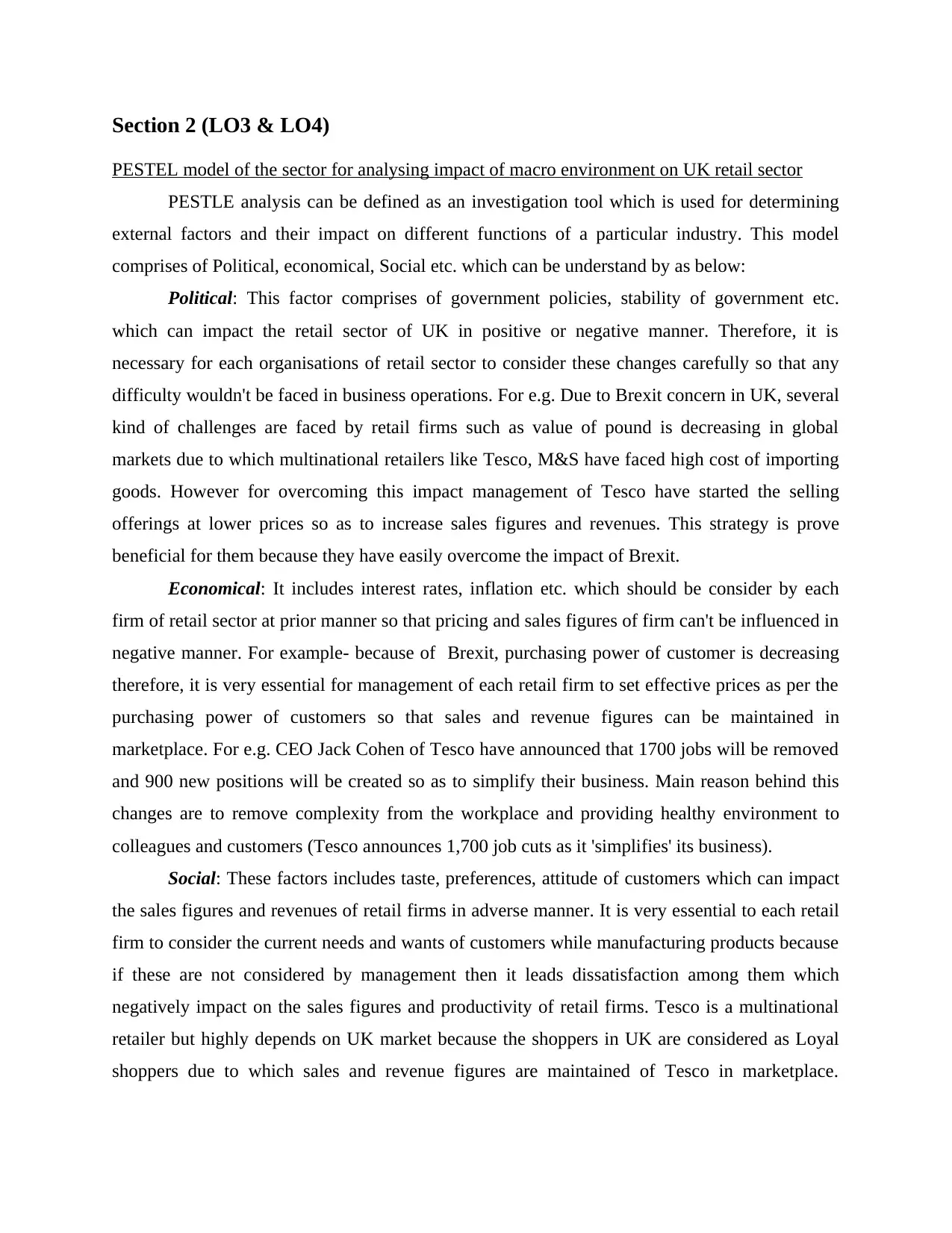
Section 2 (LO3 & LO4)
PESTEL model of the sector for analysing impact of macro environment on UK retail sector
PESTLE analysis can be defined as an investigation tool which is used for determining
external factors and their impact on different functions of a particular industry. This model
comprises of Political, economical, Social etc. which can be understand by as below:
Political: This factor comprises of government policies, stability of government etc.
which can impact the retail sector of UK in positive or negative manner. Therefore, it is
necessary for each organisations of retail sector to consider these changes carefully so that any
difficulty wouldn't be faced in business operations. For e.g. Due to Brexit concern in UK, several
kind of challenges are faced by retail firms such as value of pound is decreasing in global
markets due to which multinational retailers like Tesco, M&S have faced high cost of importing
goods. However for overcoming this impact management of Tesco have started the selling
offerings at lower prices so as to increase sales figures and revenues. This strategy is prove
beneficial for them because they have easily overcome the impact of Brexit.
Economical: It includes interest rates, inflation etc. which should be consider by each
firm of retail sector at prior manner so that pricing and sales figures of firm can't be influenced in
negative manner. For example- because of Brexit, purchasing power of customer is decreasing
therefore, it is very essential for management of each retail firm to set effective prices as per the
purchasing power of customers so that sales and revenue figures can be maintained in
marketplace. For e.g. CEO Jack Cohen of Tesco have announced that 1700 jobs will be removed
and 900 new positions will be created so as to simplify their business. Main reason behind this
changes are to remove complexity from the workplace and providing healthy environment to
colleagues and customers (Tesco announces 1,700 job cuts as it 'simplifies' its business).
Social: These factors includes taste, preferences, attitude of customers which can impact
the sales figures and revenues of retail firms in adverse manner. It is very essential to each retail
firm to consider the current needs and wants of customers while manufacturing products because
if these are not considered by management then it leads dissatisfaction among them which
negatively impact on the sales figures and productivity of retail firms. Tesco is a multinational
retailer but highly depends on UK market because the shoppers in UK are considered as Loyal
shoppers due to which sales and revenue figures are maintained of Tesco in marketplace.
PESTEL model of the sector for analysing impact of macro environment on UK retail sector
PESTLE analysis can be defined as an investigation tool which is used for determining
external factors and their impact on different functions of a particular industry. This model
comprises of Political, economical, Social etc. which can be understand by as below:
Political: This factor comprises of government policies, stability of government etc.
which can impact the retail sector of UK in positive or negative manner. Therefore, it is
necessary for each organisations of retail sector to consider these changes carefully so that any
difficulty wouldn't be faced in business operations. For e.g. Due to Brexit concern in UK, several
kind of challenges are faced by retail firms such as value of pound is decreasing in global
markets due to which multinational retailers like Tesco, M&S have faced high cost of importing
goods. However for overcoming this impact management of Tesco have started the selling
offerings at lower prices so as to increase sales figures and revenues. This strategy is prove
beneficial for them because they have easily overcome the impact of Brexit.
Economical: It includes interest rates, inflation etc. which should be consider by each
firm of retail sector at prior manner so that pricing and sales figures of firm can't be influenced in
negative manner. For example- because of Brexit, purchasing power of customer is decreasing
therefore, it is very essential for management of each retail firm to set effective prices as per the
purchasing power of customers so that sales and revenue figures can be maintained in
marketplace. For e.g. CEO Jack Cohen of Tesco have announced that 1700 jobs will be removed
and 900 new positions will be created so as to simplify their business. Main reason behind this
changes are to remove complexity from the workplace and providing healthy environment to
colleagues and customers (Tesco announces 1,700 job cuts as it 'simplifies' its business).
Social: These factors includes taste, preferences, attitude of customers which can impact
the sales figures and revenues of retail firms in adverse manner. It is very essential to each retail
firm to consider the current needs and wants of customers while manufacturing products because
if these are not considered by management then it leads dissatisfaction among them which
negatively impact on the sales figures and productivity of retail firms. Tesco is a multinational
retailer but highly depends on UK market because the shoppers in UK are considered as Loyal
shoppers due to which sales and revenue figures are maintained of Tesco in marketplace.
Paraphrase This Document
Need a fresh take? Get an instant paraphrase of this document with our AI Paraphraser
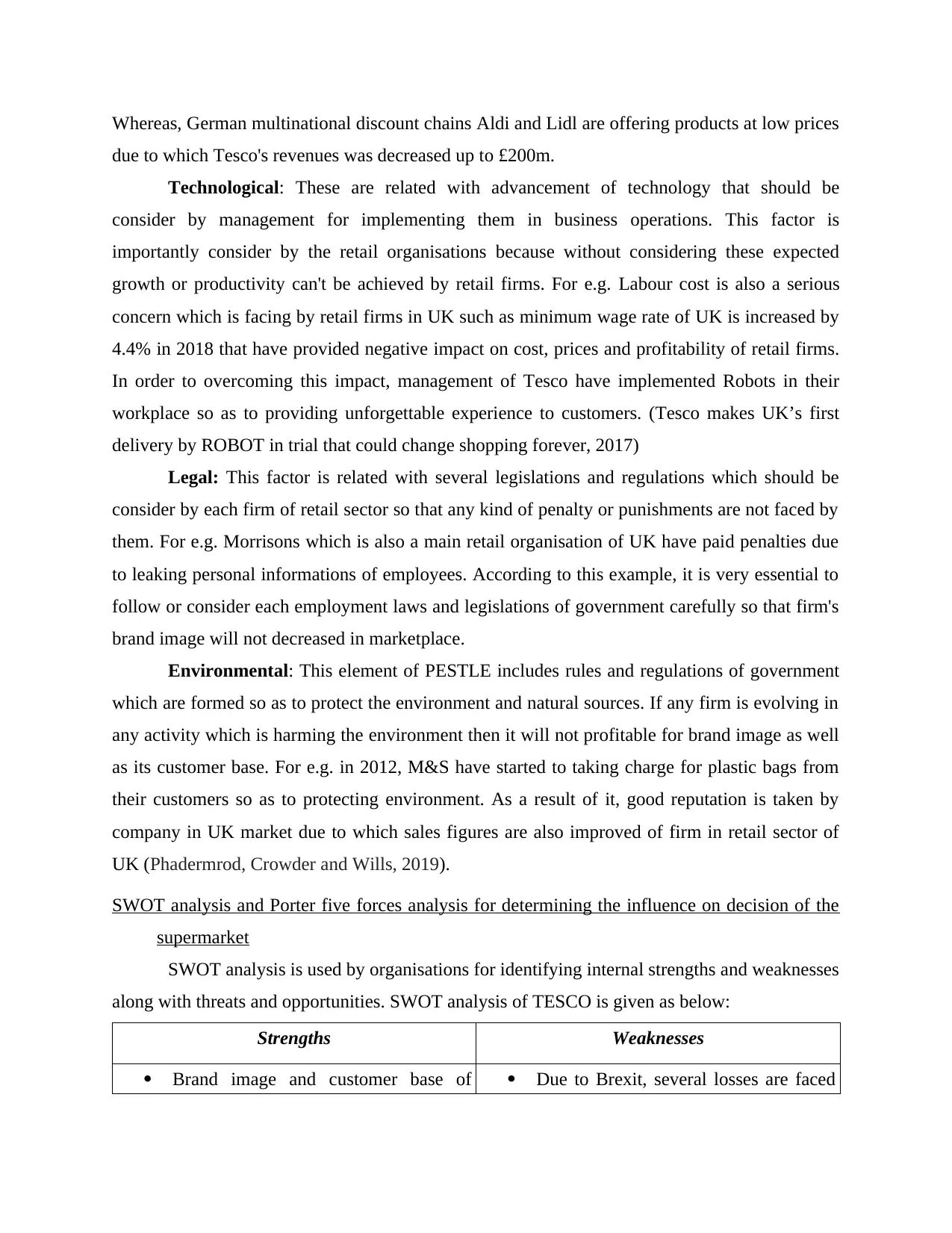
Whereas, German multinational discount chains Aldi and Lidl are offering products at low prices
due to which Tesco's revenues was decreased up to £200m.
Technological: These are related with advancement of technology that should be
consider by management for implementing them in business operations. This factor is
importantly consider by the retail organisations because without considering these expected
growth or productivity can't be achieved by retail firms. For e.g. Labour cost is also a serious
concern which is facing by retail firms in UK such as minimum wage rate of UK is increased by
4.4% in 2018 that have provided negative impact on cost, prices and profitability of retail firms.
In order to overcoming this impact, management of Tesco have implemented Robots in their
workplace so as to providing unforgettable experience to customers. (Tesco makes UK’s first
delivery by ROBOT in trial that could change shopping forever, 2017)
Legal: This factor is related with several legislations and regulations which should be
consider by each firm of retail sector so that any kind of penalty or punishments are not faced by
them. For e.g. Morrisons which is also a main retail organisation of UK have paid penalties due
to leaking personal informations of employees. According to this example, it is very essential to
follow or consider each employment laws and legislations of government carefully so that firm's
brand image will not decreased in marketplace.
Environmental: This element of PESTLE includes rules and regulations of government
which are formed so as to protect the environment and natural sources. If any firm is evolving in
any activity which is harming the environment then it will not profitable for brand image as well
as its customer base. For e.g. in 2012, M&S have started to taking charge for plastic bags from
their customers so as to protecting environment. As a result of it, good reputation is taken by
company in UK market due to which sales figures are also improved of firm in retail sector of
UK (Phadermrod, Crowder and Wills, 2019).
SWOT analysis and Porter five forces analysis for determining the influence on decision of the
supermarket
SWOT analysis is used by organisations for identifying internal strengths and weaknesses
along with threats and opportunities. SWOT analysis of TESCO is given as below:
Strengths Weaknesses
Brand image and customer base of Due to Brexit, several losses are faced
due to which Tesco's revenues was decreased up to £200m.
Technological: These are related with advancement of technology that should be
consider by management for implementing them in business operations. This factor is
importantly consider by the retail organisations because without considering these expected
growth or productivity can't be achieved by retail firms. For e.g. Labour cost is also a serious
concern which is facing by retail firms in UK such as minimum wage rate of UK is increased by
4.4% in 2018 that have provided negative impact on cost, prices and profitability of retail firms.
In order to overcoming this impact, management of Tesco have implemented Robots in their
workplace so as to providing unforgettable experience to customers. (Tesco makes UK’s first
delivery by ROBOT in trial that could change shopping forever, 2017)
Legal: This factor is related with several legislations and regulations which should be
consider by each firm of retail sector so that any kind of penalty or punishments are not faced by
them. For e.g. Morrisons which is also a main retail organisation of UK have paid penalties due
to leaking personal informations of employees. According to this example, it is very essential to
follow or consider each employment laws and legislations of government carefully so that firm's
brand image will not decreased in marketplace.
Environmental: This element of PESTLE includes rules and regulations of government
which are formed so as to protect the environment and natural sources. If any firm is evolving in
any activity which is harming the environment then it will not profitable for brand image as well
as its customer base. For e.g. in 2012, M&S have started to taking charge for plastic bags from
their customers so as to protecting environment. As a result of it, good reputation is taken by
company in UK market due to which sales figures are also improved of firm in retail sector of
UK (Phadermrod, Crowder and Wills, 2019).
SWOT analysis and Porter five forces analysis for determining the influence on decision of the
supermarket
SWOT analysis is used by organisations for identifying internal strengths and weaknesses
along with threats and opportunities. SWOT analysis of TESCO is given as below:
Strengths Weaknesses
Brand image and customer base of Due to Brexit, several losses are faced
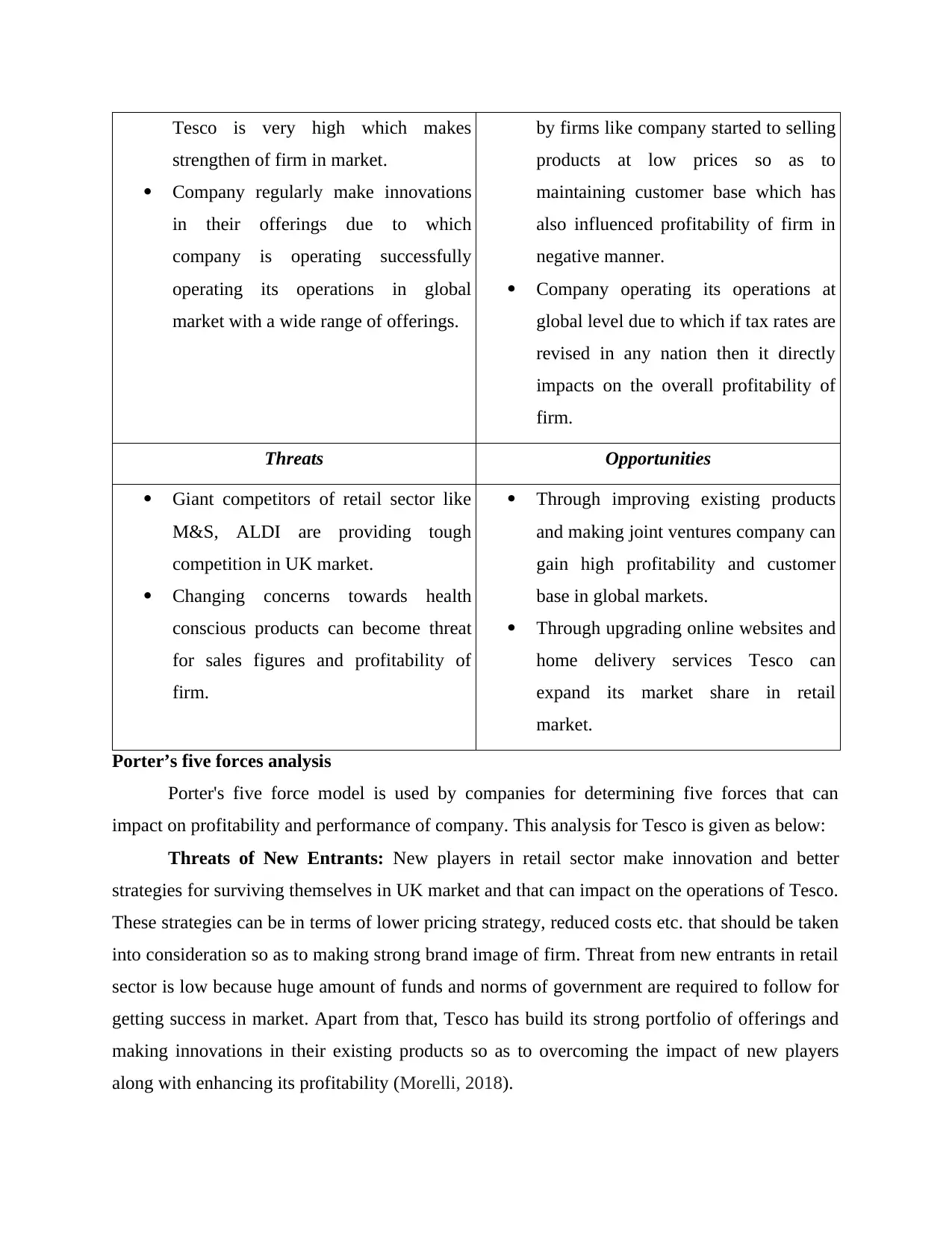
Tesco is very high which makes
strengthen of firm in market.
Company regularly make innovations
in their offerings due to which
company is operating successfully
operating its operations in global
market with a wide range of offerings.
by firms like company started to selling
products at low prices so as to
maintaining customer base which has
also influenced profitability of firm in
negative manner.
Company operating its operations at
global level due to which if tax rates are
revised in any nation then it directly
impacts on the overall profitability of
firm.
Threats Opportunities
Giant competitors of retail sector like
M&S, ALDI are providing tough
competition in UK market.
Changing concerns towards health
conscious products can become threat
for sales figures and profitability of
firm.
Through improving existing products
and making joint ventures company can
gain high profitability and customer
base in global markets.
Through upgrading online websites and
home delivery services Tesco can
expand its market share in retail
market.
Porter’s five forces analysis
Porter's five force model is used by companies for determining five forces that can
impact on profitability and performance of company. This analysis for Tesco is given as below:
Threats of New Entrants: New players in retail sector make innovation and better
strategies for surviving themselves in UK market and that can impact on the operations of Tesco.
These strategies can be in terms of lower pricing strategy, reduced costs etc. that should be taken
into consideration so as to making strong brand image of firm. Threat from new entrants in retail
sector is low because huge amount of funds and norms of government are required to follow for
getting success in market. Apart from that, Tesco has build its strong portfolio of offerings and
making innovations in their existing products so as to overcoming the impact of new players
along with enhancing its profitability (Morelli, 2018).
strengthen of firm in market.
Company regularly make innovations
in their offerings due to which
company is operating successfully
operating its operations in global
market with a wide range of offerings.
by firms like company started to selling
products at low prices so as to
maintaining customer base which has
also influenced profitability of firm in
negative manner.
Company operating its operations at
global level due to which if tax rates are
revised in any nation then it directly
impacts on the overall profitability of
firm.
Threats Opportunities
Giant competitors of retail sector like
M&S, ALDI are providing tough
competition in UK market.
Changing concerns towards health
conscious products can become threat
for sales figures and profitability of
firm.
Through improving existing products
and making joint ventures company can
gain high profitability and customer
base in global markets.
Through upgrading online websites and
home delivery services Tesco can
expand its market share in retail
market.
Porter’s five forces analysis
Porter's five force model is used by companies for determining five forces that can
impact on profitability and performance of company. This analysis for Tesco is given as below:
Threats of New Entrants: New players in retail sector make innovation and better
strategies for surviving themselves in UK market and that can impact on the operations of Tesco.
These strategies can be in terms of lower pricing strategy, reduced costs etc. that should be taken
into consideration so as to making strong brand image of firm. Threat from new entrants in retail
sector is low because huge amount of funds and norms of government are required to follow for
getting success in market. Apart from that, Tesco has build its strong portfolio of offerings and
making innovations in their existing products so as to overcoming the impact of new players
along with enhancing its profitability (Morelli, 2018).
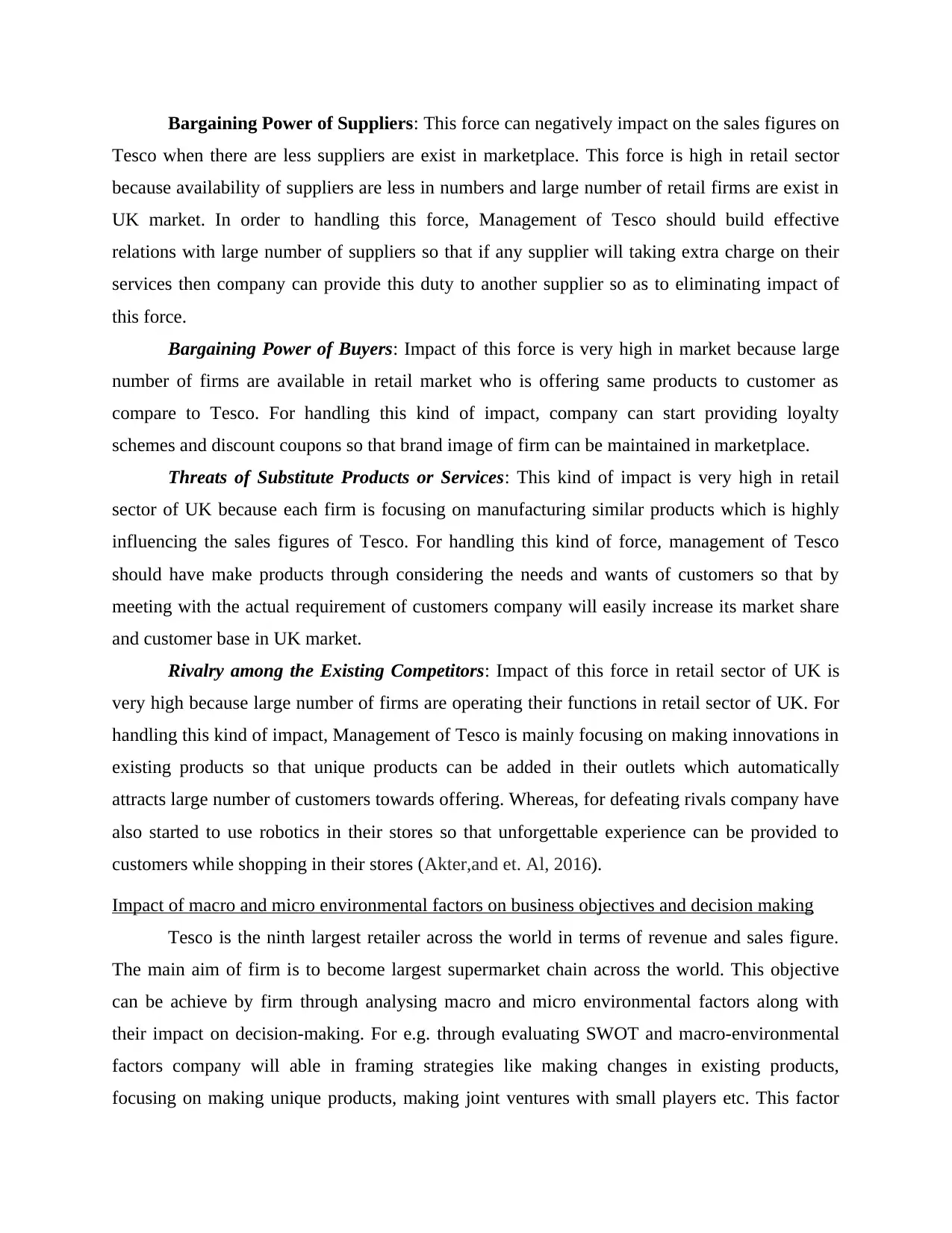
Bargaining Power of Suppliers: This force can negatively impact on the sales figures on
Tesco when there are less suppliers are exist in marketplace. This force is high in retail sector
because availability of suppliers are less in numbers and large number of retail firms are exist in
UK market. In order to handling this force, Management of Tesco should build effective
relations with large number of suppliers so that if any supplier will taking extra charge on their
services then company can provide this duty to another supplier so as to eliminating impact of
this force.
Bargaining Power of Buyers: Impact of this force is very high in market because large
number of firms are available in retail market who is offering same products to customer as
compare to Tesco. For handling this kind of impact, company can start providing loyalty
schemes and discount coupons so that brand image of firm can be maintained in marketplace.
Threats of Substitute Products or Services: This kind of impact is very high in retail
sector of UK because each firm is focusing on manufacturing similar products which is highly
influencing the sales figures of Tesco. For handling this kind of force, management of Tesco
should have make products through considering the needs and wants of customers so that by
meeting with the actual requirement of customers company will easily increase its market share
and customer base in UK market.
Rivalry among the Existing Competitors: Impact of this force in retail sector of UK is
very high because large number of firms are operating their functions in retail sector of UK. For
handling this kind of impact, Management of Tesco is mainly focusing on making innovations in
existing products so that unique products can be added in their outlets which automatically
attracts large number of customers towards offering. Whereas, for defeating rivals company have
also started to use robotics in their stores so that unforgettable experience can be provided to
customers while shopping in their stores (Akter,and et. Al, 2016).
Impact of macro and micro environmental factors on business objectives and decision making
Tesco is the ninth largest retailer across the world in terms of revenue and sales figure.
The main aim of firm is to become largest supermarket chain across the world. This objective
can be achieve by firm through analysing macro and micro environmental factors along with
their impact on decision-making. For e.g. through evaluating SWOT and macro-environmental
factors company will able in framing strategies like making changes in existing products,
focusing on making unique products, making joint ventures with small players etc. This factor
Tesco when there are less suppliers are exist in marketplace. This force is high in retail sector
because availability of suppliers are less in numbers and large number of retail firms are exist in
UK market. In order to handling this force, Management of Tesco should build effective
relations with large number of suppliers so that if any supplier will taking extra charge on their
services then company can provide this duty to another supplier so as to eliminating impact of
this force.
Bargaining Power of Buyers: Impact of this force is very high in market because large
number of firms are available in retail market who is offering same products to customer as
compare to Tesco. For handling this kind of impact, company can start providing loyalty
schemes and discount coupons so that brand image of firm can be maintained in marketplace.
Threats of Substitute Products or Services: This kind of impact is very high in retail
sector of UK because each firm is focusing on manufacturing similar products which is highly
influencing the sales figures of Tesco. For handling this kind of force, management of Tesco
should have make products through considering the needs and wants of customers so that by
meeting with the actual requirement of customers company will easily increase its market share
and customer base in UK market.
Rivalry among the Existing Competitors: Impact of this force in retail sector of UK is
very high because large number of firms are operating their functions in retail sector of UK. For
handling this kind of impact, Management of Tesco is mainly focusing on making innovations in
existing products so that unique products can be added in their outlets which automatically
attracts large number of customers towards offering. Whereas, for defeating rivals company have
also started to use robotics in their stores so that unforgettable experience can be provided to
customers while shopping in their stores (Akter,and et. Al, 2016).
Impact of macro and micro environmental factors on business objectives and decision making
Tesco is the ninth largest retailer across the world in terms of revenue and sales figure.
The main aim of firm is to become largest supermarket chain across the world. This objective
can be achieve by firm through analysing macro and micro environmental factors along with
their impact on decision-making. For e.g. through evaluating SWOT and macro-environmental
factors company will able in framing strategies like making changes in existing products,
focusing on making unique products, making joint ventures with small players etc. This factor
Secure Best Marks with AI Grader
Need help grading? Try our AI Grader for instant feedback on your assignments.
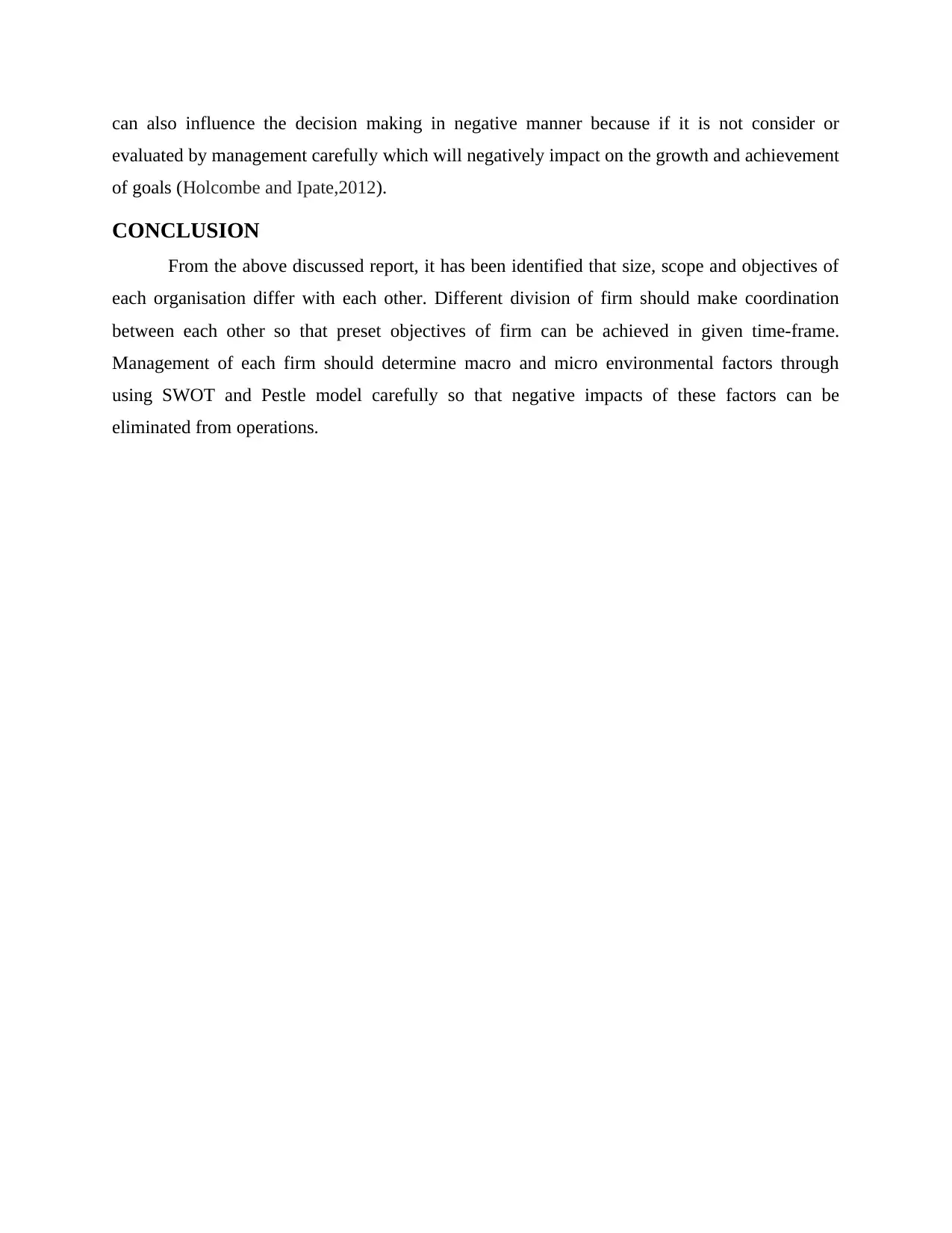
can also influence the decision making in negative manner because if it is not consider or
evaluated by management carefully which will negatively impact on the growth and achievement
of goals (Holcombe and Ipate,2012).
CONCLUSION
From the above discussed report, it has been identified that size, scope and objectives of
each organisation differ with each other. Different division of firm should make coordination
between each other so that preset objectives of firm can be achieved in given time-frame.
Management of each firm should determine macro and micro environmental factors through
using SWOT and Pestle model carefully so that negative impacts of these factors can be
eliminated from operations.
evaluated by management carefully which will negatively impact on the growth and achievement
of goals (Holcombe and Ipate,2012).
CONCLUSION
From the above discussed report, it has been identified that size, scope and objectives of
each organisation differ with each other. Different division of firm should make coordination
between each other so that preset objectives of firm can be achieved in given time-frame.
Management of each firm should determine macro and micro environmental factors through
using SWOT and Pestle model carefully so that negative impacts of these factors can be
eliminated from operations.
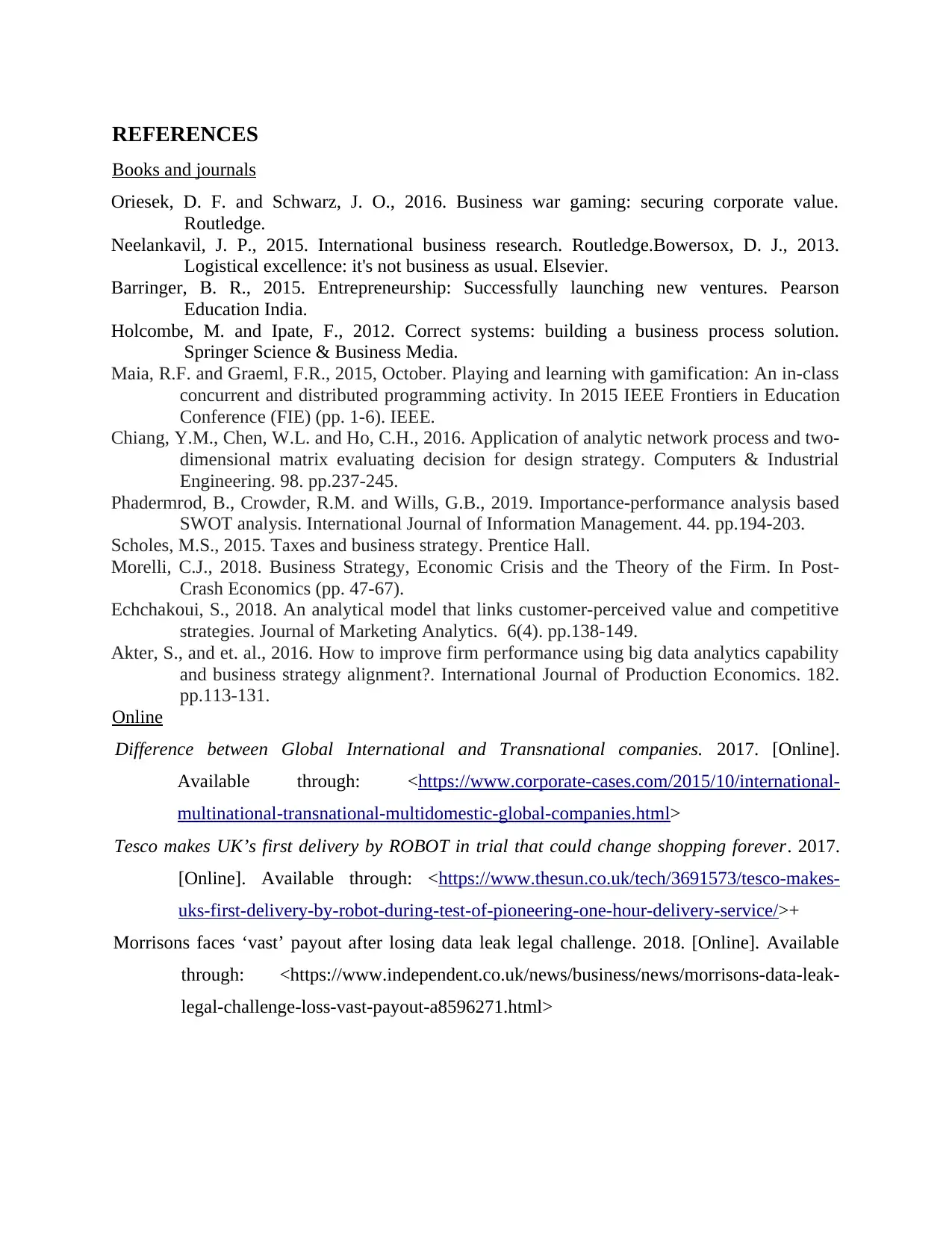
REFERENCES
Books and journals
Oriesek, D. F. and Schwarz, J. O., 2016. Business war gaming: securing corporate value.
Routledge.
Neelankavil, J. P., 2015. International business research. Routledge.Bowersox, D. J., 2013.
Logistical excellence: it's not business as usual. Elsevier.
Barringer, B. R., 2015. Entrepreneurship: Successfully launching new ventures. Pearson
Education India.
Holcombe, M. and Ipate, F., 2012. Correct systems: building a business process solution.
Springer Science & Business Media.
Maia, R.F. and Graeml, F.R., 2015, October. Playing and learning with gamification: An in-class
concurrent and distributed programming activity. In 2015 IEEE Frontiers in Education
Conference (FIE) (pp. 1-6). IEEE.
Chiang, Y.M., Chen, W.L. and Ho, C.H., 2016. Application of analytic network process and two-
dimensional matrix evaluating decision for design strategy. Computers & Industrial
Engineering. 98. pp.237-245.
Phadermrod, B., Crowder, R.M. and Wills, G.B., 2019. Importance-performance analysis based
SWOT analysis. International Journal of Information Management. 44. pp.194-203.
Scholes, M.S., 2015. Taxes and business strategy. Prentice Hall.
Morelli, C.J., 2018. Business Strategy, Economic Crisis and the Theory of the Firm. In Post-
Crash Economics (pp. 47-67).
Echchakoui, S., 2018. An analytical model that links customer-perceived value and competitive
strategies. Journal of Marketing Analytics. 6(4). pp.138-149.
Akter, S., and et. al., 2016. How to improve firm performance using big data analytics capability
and business strategy alignment?. International Journal of Production Economics. 182.
pp.113-131.
Online
Difference between Global International and Transnational companies. 2017. [Online].
Available through: <https://www.corporate-cases.com/2015/10/international-
multinational-transnational-multidomestic-global-companies.html>
Tesco makes UK’s first delivery by ROBOT in trial that could change shopping forever. 2017.
[Online]. Available through: <https://www.thesun.co.uk/tech/3691573/tesco-makes-
uks-first-delivery-by-robot-during-test-of-pioneering-one-hour-delivery-service/>+
Morrisons faces ‘vast’ payout after losing data leak legal challenge. 2018. [Online]. Available
through: <https://www.independent.co.uk/news/business/news/morrisons-data-leak-
legal-challenge-loss-vast-payout-a8596271.html>
Books and journals
Oriesek, D. F. and Schwarz, J. O., 2016. Business war gaming: securing corporate value.
Routledge.
Neelankavil, J. P., 2015. International business research. Routledge.Bowersox, D. J., 2013.
Logistical excellence: it's not business as usual. Elsevier.
Barringer, B. R., 2015. Entrepreneurship: Successfully launching new ventures. Pearson
Education India.
Holcombe, M. and Ipate, F., 2012. Correct systems: building a business process solution.
Springer Science & Business Media.
Maia, R.F. and Graeml, F.R., 2015, October. Playing and learning with gamification: An in-class
concurrent and distributed programming activity. In 2015 IEEE Frontiers in Education
Conference (FIE) (pp. 1-6). IEEE.
Chiang, Y.M., Chen, W.L. and Ho, C.H., 2016. Application of analytic network process and two-
dimensional matrix evaluating decision for design strategy. Computers & Industrial
Engineering. 98. pp.237-245.
Phadermrod, B., Crowder, R.M. and Wills, G.B., 2019. Importance-performance analysis based
SWOT analysis. International Journal of Information Management. 44. pp.194-203.
Scholes, M.S., 2015. Taxes and business strategy. Prentice Hall.
Morelli, C.J., 2018. Business Strategy, Economic Crisis and the Theory of the Firm. In Post-
Crash Economics (pp. 47-67).
Echchakoui, S., 2018. An analytical model that links customer-perceived value and competitive
strategies. Journal of Marketing Analytics. 6(4). pp.138-149.
Akter, S., and et. al., 2016. How to improve firm performance using big data analytics capability
and business strategy alignment?. International Journal of Production Economics. 182.
pp.113-131.
Online
Difference between Global International and Transnational companies. 2017. [Online].
Available through: <https://www.corporate-cases.com/2015/10/international-
multinational-transnational-multidomestic-global-companies.html>
Tesco makes UK’s first delivery by ROBOT in trial that could change shopping forever. 2017.
[Online]. Available through: <https://www.thesun.co.uk/tech/3691573/tesco-makes-
uks-first-delivery-by-robot-during-test-of-pioneering-one-hour-delivery-service/>+
Morrisons faces ‘vast’ payout after losing data leak legal challenge. 2018. [Online]. Available
through: <https://www.independent.co.uk/news/business/news/morrisons-data-leak-
legal-challenge-loss-vast-payout-a8596271.html>
1 out of 12
Related Documents
Your All-in-One AI-Powered Toolkit for Academic Success.
+13062052269
info@desklib.com
Available 24*7 on WhatsApp / Email
![[object Object]](/_next/static/media/star-bottom.7253800d.svg)
Unlock your academic potential
© 2024 | Zucol Services PVT LTD | All rights reserved.





